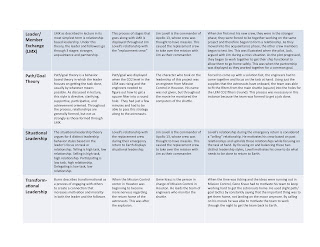Thursday, March 24, 2011
Tuesday, March 8, 2011
Transforming the Leadership Theory
James McGregor Burns is a leader that took a very different outlook on leadership theory. His theory, transformational leadership proposes that this "occurs when one or more persons engage with others in such a way that leaders and followers raise one another to higher levels of motivation and morality." In this theory the leader focuses on the needs of his followers and this helps to create a sense of loyalty for the leader and his ideas. In additional to transformational leadership, Burns also contributed greatly to the visionary and aspirational schools of thought. Burns' contributions have improved the leader follower relationship.
Below is a video from one of my favorite movies, Miracle. In this speech the coach inspires his team to perform their best and engages them to play at that higher level.
This slide show is my take on transformational leadership...I hope you enjoy!
Wednesday, March 2, 2011
Contingency Theory vs. Situational Leadership Theory
Situational Leadership Theory
Contingency Theory
An example of the contingency theory and its effectiveness is displayed in a static workplace. In many work environments management is static, but hourly employees are constantly changing. If the management is not constantly adapting to its staff, then they will continually have that turnover. The mismatch causes a need for some change.
- Four basic leadership behavior styles
- High task, low relationship (telling)
- High task, high relationship (selling)
- Low task, high relationship (participating)
- Low task, low relationship (delegating)
- Most effective style is different for each group-dependent on readiness which is composed of
- Ability
- Willingness
- Also dependent on the job performed
Contingency Theory
- Two factors
- Least preferred co-worker
- Measures leadership orientation
- Relationship or task?
- Situational favorableness
- No ideal leader
- Environment and followers should contribute to leadership style
- Match vs. mismatch (leader and situation)
- If there is a mismatch you may need to change the leader
An example of the contingency theory and its effectiveness is displayed in a static workplace. In many work environments management is static, but hourly employees are constantly changing. If the management is not constantly adapting to its staff, then they will continually have that turnover. The mismatch causes a need for some change.
Tuesday, March 1, 2011
Outsourced
After a recommendation of my boss at work, I began watching "Outsourced," which is now in its second season. The show is based on Todd, an American whose call center in the United States was closed and outsourced while he was at management training. He was promoted to manage the call center, but the catch was it is now in India. The show follows his life and his challenges, especially culturally, managing the call center.
The characters I will examine to determine whether they lean more towards path/goal or LMX are Jerry (Todd's boss), Todd (Call Center Manager) and Rajiv (Todd's Assistant Manager). The clip below shows a glimpse of each leader's interactions with coworkers.
Jerry (Todd's Boss)
Rajiv (Todd's Assistant Manager)
The characters I will examine to determine whether they lean more towards path/goal or LMX are Jerry (Todd's boss), Todd (Call Center Manager) and Rajiv (Todd's Assistant Manager). The clip below shows a glimpse of each leader's interactions with coworkers.
Jerry (Todd's Boss)
- Jerry displays path/goal leadership with his choice to send the call center to India. He had a goal, which was to reduce cost, and to achieve that goal he outsourced his company and laid off his US employees. His direction to Todd was clear, and that was to run the call center based on his training and that if he did not want to go to India he would not have a job.
- Todd is a LMX leader. Immediately upon his arrival in India he works with the call center employees to ensure they understand US culture. The best display of his LMX leadership is towards the end of the clip when he encourages Madhuri (a quiet call center employee) to take a call on her own and speak up. After this first hurdle, Madhuri proves to be a valuable employee. By focusing on building these relationships, Todd has the most loyal call center employees in the entire building.
Rajiv (Todd's Assistant Manager)
- Rajiv is a path/goal leader who rules with an iron fist. If it were not for Todd, Rajiv would have fired all of the employees within season 1 of the show. He is very strict about quotas and policies and does not care to form relationships with them employees.
My blog vs. others
After reading many other students' blogs I have noticed that each person has taken a different path in creating their blog. Although the paths are different the end goal is still achieved, and that is to help develop our leadership styles. To compare and contrast I chose Shilo's blog as a similar blog, and Dan's blog as a different blog.
Shilo's Blog (click here)
Shilo's Blog (click here)
- As I did, Shilo followed a template to create his blog. This gives a feeling of unity among the blog. The color schemes match, and as a reader you get a simple feeling
- His content is similar to mine in the sense that it is concise and written from his perspective. I think that this makes the blog personal and allows the reader to feel like they have entered your life.
- Dan's blog is just like Dan himself, different. He is very involved in the blog outside of just the assignments with posts just about everyday. I like that he is taking this beyond the requirements.
- The layout of Dan's blog is a little difficult to understand, but if you a regular follower you can get used to it.
Subscribe to:
Comments (Atom)



